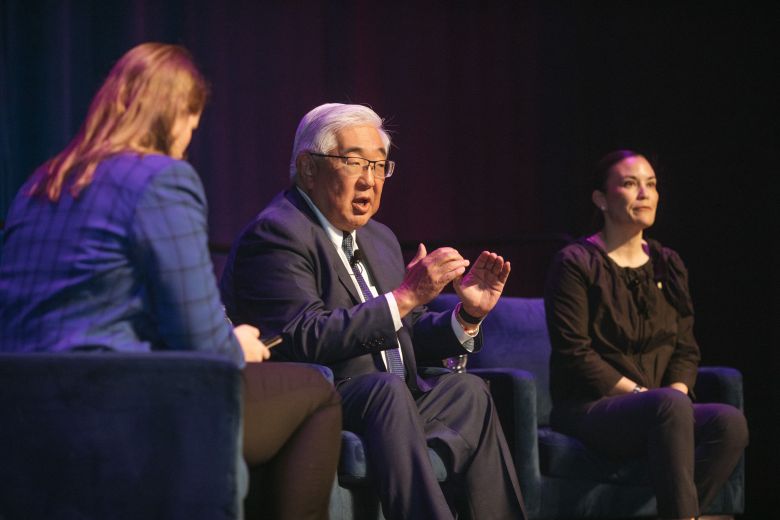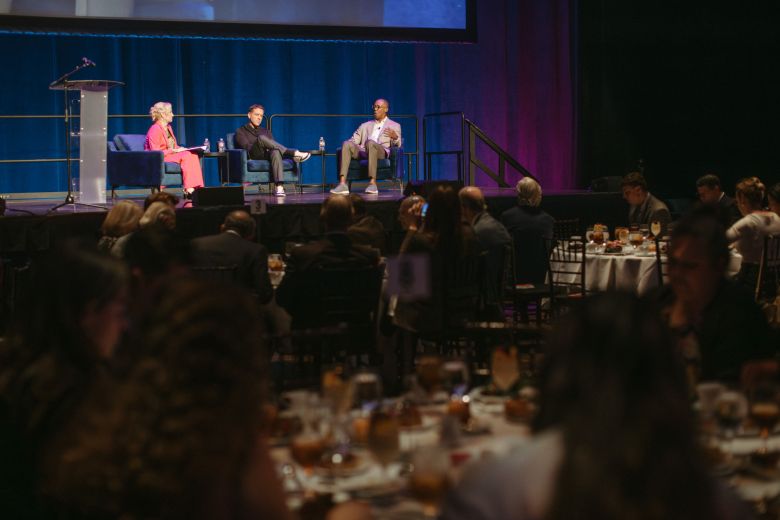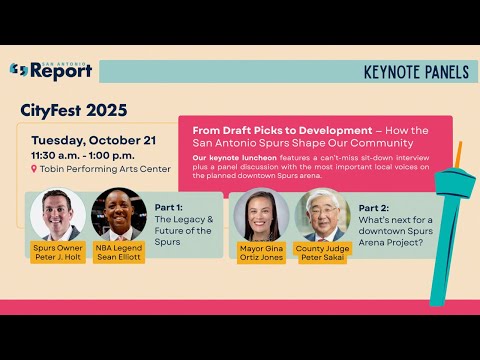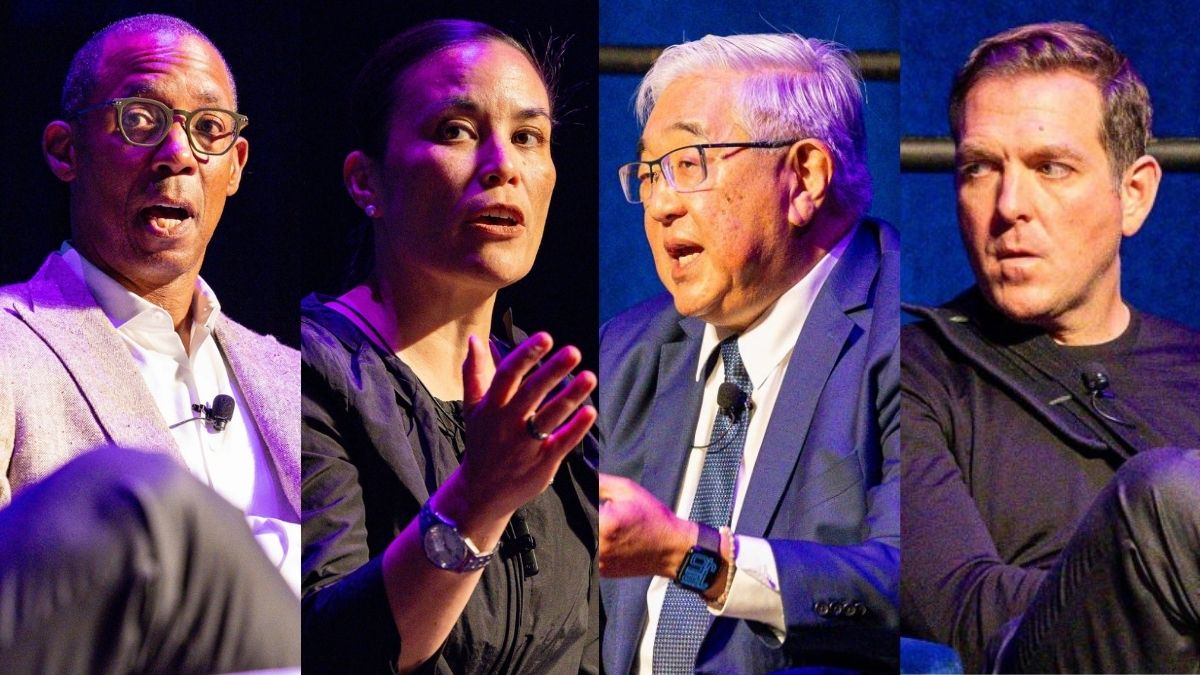With early voting underway, Spurs Chairman Peter J. Holt, former NBA Spurs forward Sean Elliott, Bexar County Judge Peter Sakai and San Antonio Mayor Gina Ortiz Jones gathered at the Tobin Center Tuesday to talk about the tangible — and intangible — calculations behind a proposed $1.3 billion downtown arena.
In a keynote panel for the San Antonio Report’s 2025 CityFest, hosted by San Antonio Report Editor in Chief Leigh Munsil, Sakai and Jones each talked about the factors driving their decisions on whether to put public dollars toward the project.
Sakai was initially skeptical about committing county money to an arena that would move that team out of the county-owned Frost Bank Center on the East Side. At the time the team’s owners approached him about it, there was no plan for the existing facilities, no price tag for the new arena, and the team hadn’t said how much it would contribute.
On Tuesday, however, Sakai said his decision to ask voters to designate roughly two thirds of the county’s venue tax capacity to the project in this Nov. 4 election — and one third to converting the East Side facilities for a new use — came down to his belief that the keeping the team in San Antonio has benefits beyond what can be seen in a traditional financial analysis.
“What needs to be determined is the value of the Spurs,” Sakai said. “The value of the Spurs as a major employer, who creates a lot of jobs and economic development. We need to put value to them as a corporate citizen.”
He believes that with federal cuts coming to the social safety net, the county will be leaning hard on San Antonio companies to help make up for that money, and can’t afford to lose any of them.
“If we’re headed toward those dark times … major employers such as the Spurs, USAA, Valero, on and on, those big, major corporations that give much, we’re going to have to really tap them and say, ‘What can we do for the least of us?’” Sakai said.
 From left to right, San Antonio Report Editor in Chief Leigh Munsil, Bexar County Judge Peter Sakai and San Antonio Mayor Gina Ortiz Jones discuss the Spurs downtown arena project during the San Antonio Report’s CityFest 2025 keynote at the Tobin Performing Arts Center on Oct. 21, 2025. Credit: Vincent Reyna for the San Antonio Report
From left to right, San Antonio Report Editor in Chief Leigh Munsil, Bexar County Judge Peter Sakai and San Antonio Mayor Gina Ortiz Jones discuss the Spurs downtown arena project during the San Antonio Report’s CityFest 2025 keynote at the Tobin Performing Arts Center on Oct. 21, 2025. Credit: Vincent Reyna for the San Antonio Report
The Spurs haven’t actually said whether they would consider moving to another city if Proposition B doesn’t pass to help fund a new arena.
Before Sakai took the stage, San Antonio Report Publisher Angie Mock asked Holt directly about the prospect moments earlier in the first of two CityFest panels.
“We’re not focused on that …. we’re focused on this election,” Holt said. “We wouldn’t be investing so much time and energy in the campaign, and then so much investment dollars in the actual project, if we didn’t think that it was absolutely the right thing for the Spurs and the community.”
A different perspective
Like Sakai, Jones said the data points weighing heavily on her calculations are also related to the impending federal cuts to Medicaid, Social Security, children’s health care and food stamps.
“It is hard for me to not think about these things, the very strong financial headwinds that are coming our way, as we also think about this generational investment,” said Jones, who voted against the city and county’s deal with the Spurs as currently structured — and who maintains San Antonio should drive a harder bargain.
The city already faces a budget deficit that’s projected to grow exponentially in the coming years, and Jones said that tying up the property taxes the new arena district would generate in a Tax Increment Reinvestment Zone means that long-term, the city will ultimately have to spend less elsewhere to make up for it.
“That is money that stays in that same area, that would help to finance the arena,” she said. “That’s important, but we also should understand, that is money that is then not coming into the general fund to help us pay for other things.”
Holt, meanwhile, contended that not enough attention has been paid to the additional sales tax the sports and entertainment district would contribute to city and county coffers.
“There’s been, unfortunately, too little explanation of the [ways] the community will benefit from this directly,” he said on the first panel.
 San Antonio Mayor Gina Ortiz Jones talks about the Spurs downtown arena project during the San Antonio Report’s 2025 CityFest at the Tobin Performing Arts Center on Tuesday. Credit: Amber Esparza / San Antonio Report
San Antonio Mayor Gina Ortiz Jones talks about the Spurs downtown arena project during the San Antonio Report’s 2025 CityFest at the Tobin Performing Arts Center on Tuesday. Credit: Amber Esparza / San Antonio Report
Jones, who took the stage after Holt and Elliott, said a more fulsome explanation of costs surrounding the arena project is also needed.
She noted new uncertainty surrounding some funds the city penciled into its original plans for the sports and entertainment district, such as a land bridge shown in Project Marvel renderings.
That idea was dependent on a Biden-era Reconnecting Communities grant, and Jones said the city has already paused on some federally funded projects that it’s no longer sure it will be reimbursed for by the new administration.
A SAWS water chilling plant is also moving to make way for a convention center expansion at the heart of Project Marvel, and more than $200 million from a future city bond election is already earmarked for Marvel-related infrastructure.
“There are other things that also go along with a revitalized downtown that also have a price tag, even if it’s not specific to the arena,” she said. “It’s a part of the entire plan, and I think that’s how we have to think about this, writ large, even though it’s complex.”
If Proposition B passes, City Manager Erik Walsh indicated he’ll have what he needs to move forward with the city’s own $489 million investment in the arena, which doesn’t require a public vote after the City Council approved the framework in August.
But Jones, who was elected midway through the negotiations, said regardless of the Nov. 4 election results, she doesn’t consider that agreement to be the final offer from either the city or the team.
She wants the city to consider paying for some of the entertainment district infrastructure with state money it will receive from a Project Finance Zone instead of a city infrastructure bond, and keep negotiating over who gets the profit from arena naming rights, concessions and parking.
“There are several project agreements that, should Proposition B pass, we still need to finalize,” she said. “The term sheet is non-binding at this point.”
Though she remains one of the biggest skeptics of the $800 million public funding agreement, Jones also said Tuesday that if Prop B fails, the city would continue working toward a deal to help fund a downtown arena — if the team wants to pursue it.
Spurs’ closing pitch
Tuesday’s discussion comes as the only public polling on Proposition B, from UTSA, showed its support underwater.
Holt said the vote is “giving me gray [hair],” but he believes the measure will pass.
To sweeten the deal, he made an eleventh-hour announcement about plans to turn the team’s former practice facility in the South Texas Medical Center into a multipurpose community center.
The Spurs moved into a new practice facility at the Rock at La Cantera in 2023, which received $32 million in tax incentives from the city and county.
Holt and Elliott said repurposing the old facility for children is an example of the Spurs’ longstanding commitment to the community, which goes far beyond what other NBA teams typically offer.
“Probably the business-savvy thing to do would be just to sell that building off and make some money off of it,” Holt said. “But we’re going to reinvest $10 million into that and make that a community center for teaching coaches and teaching kids the right way to not only show up in sports, but show up in life.”
 San Antonio Report Publisher Angie Mock, San Antonio Spurs Owner and Managing Partner Peter J. Holt and former Spurs player Sean Elliot talk about the Spurs’ legacy and the team’s future. Credit: Vincent Reyna for the San Antonio Report
San Antonio Report Publisher Angie Mock, San Antonio Spurs Owner and Managing Partner Peter J. Holt and former Spurs player Sean Elliot talk about the Spurs’ legacy and the team’s future. Credit: Vincent Reyna for the San Antonio Report
Meanwhile, Elliott recalled the team’s original owners’ push for players to be role models, dating all the way back to when he moved here from Arizona as a rookie in 1989.
“Early on, [Red McCombs] sent me and [then-Coach Gregg Popovich] on a little shuttle bus throughout South Texas to drum up support, and then when I got back during the season … if we had a day off, the Spurs were asking us to go to an elementary school, a junior high school, high school, a youth center to talk to kids …
It was apparent that Red and Charlene [McCombs] wanted to use the Spurs as an instrument to better the community,” Elliott said.
CityFest continues Wednesday and Thursday with free panels discussing what’s next for San Antonio’s East Side and the small businesses that bring a sports and entertainment district to life. Please RSVP to attend.
Watch the full event:


